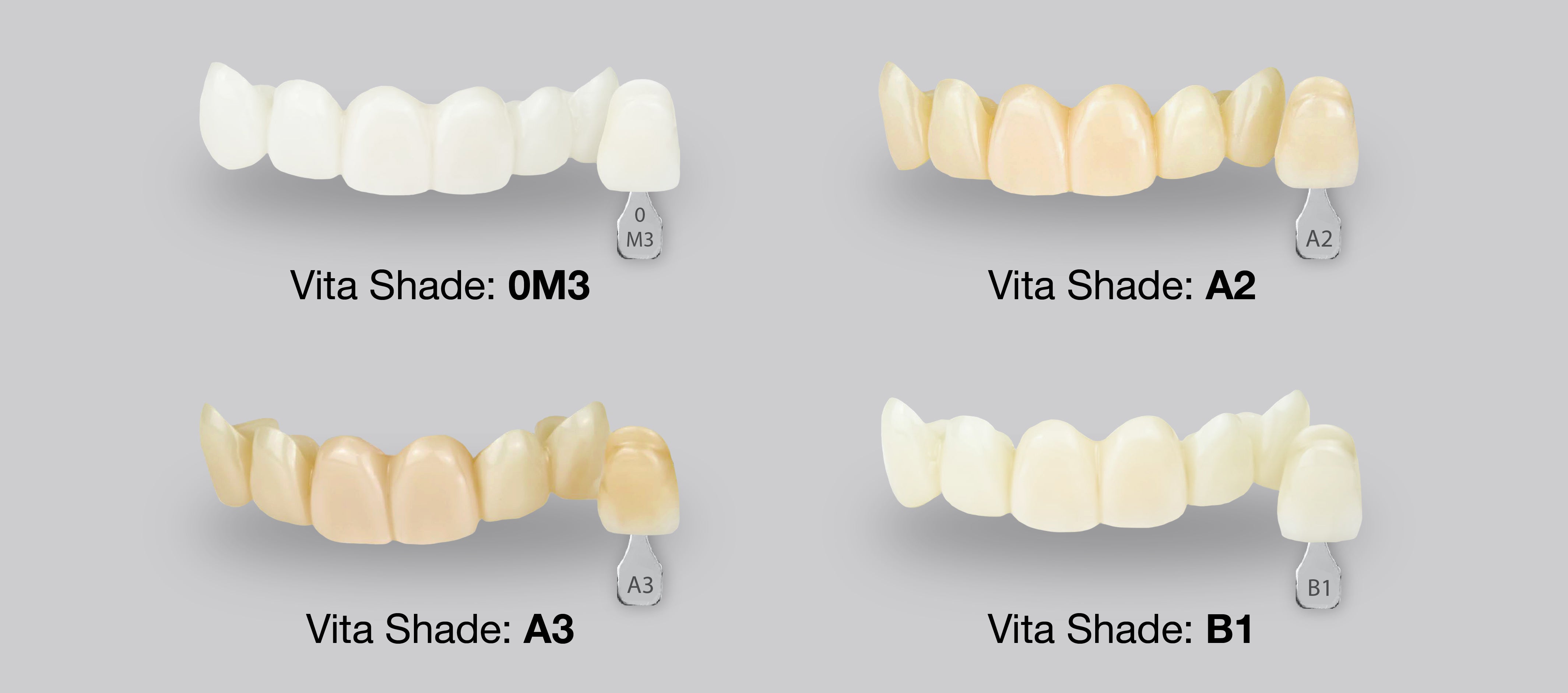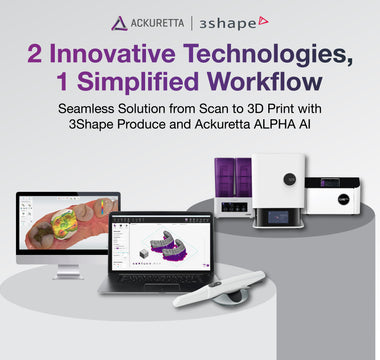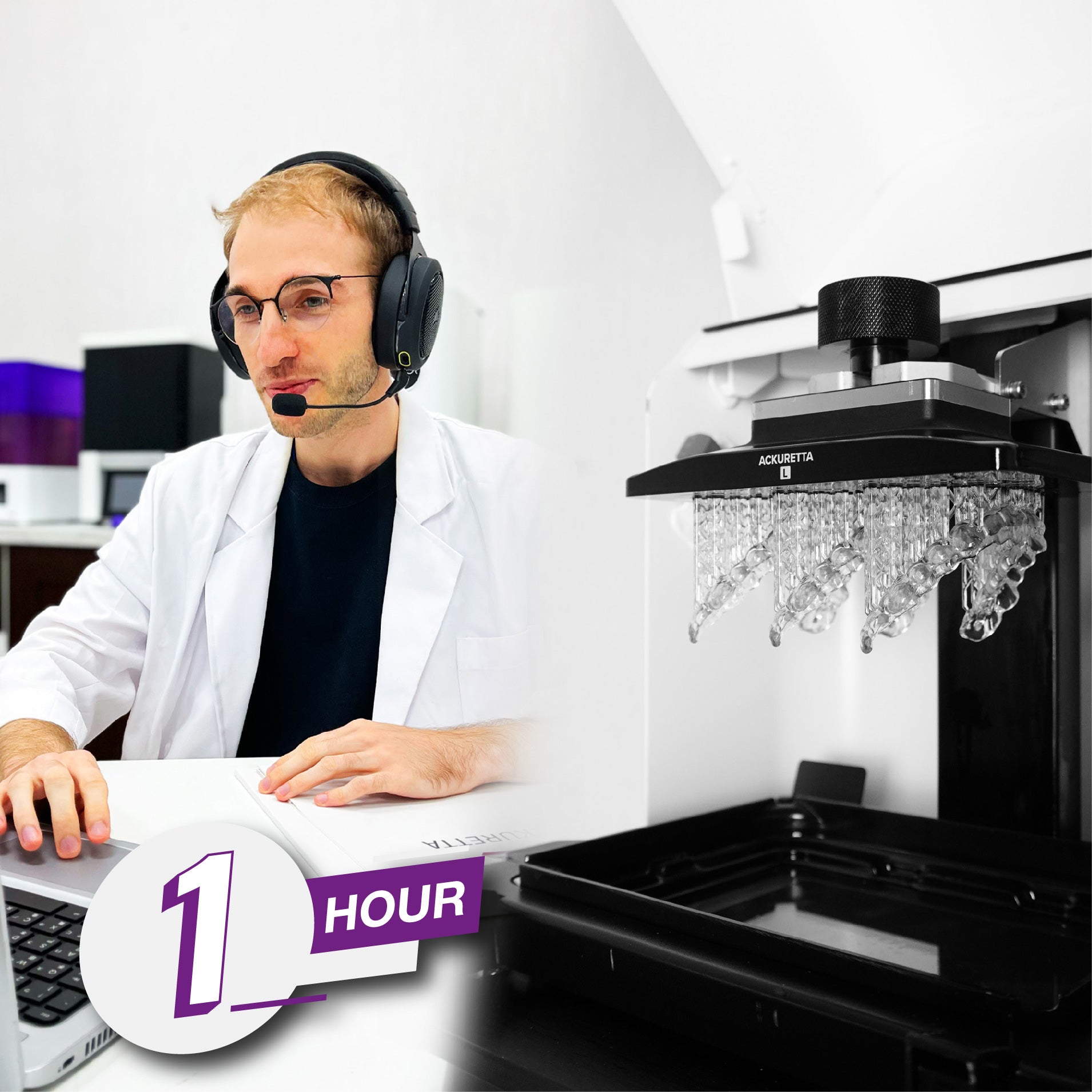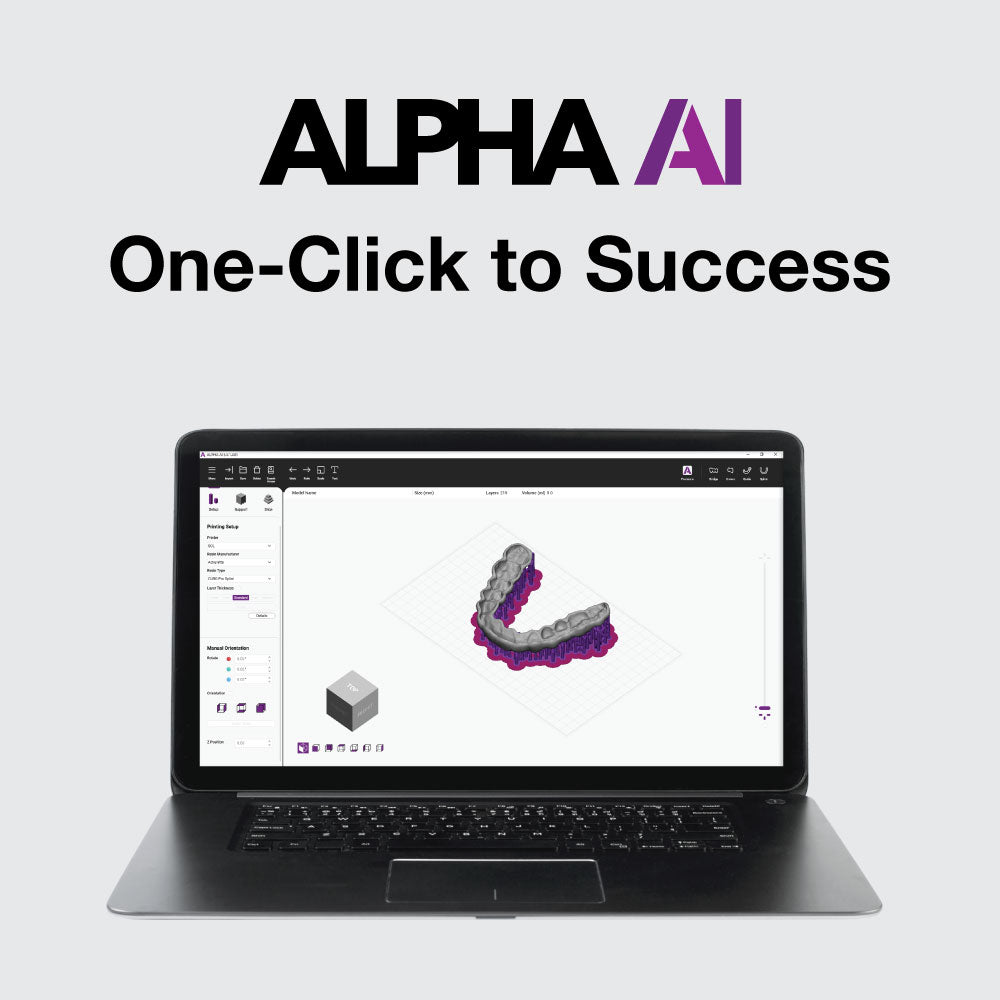Milling or 3D Printing:
What’s the best Dental Technology for you?

Dentistry has witnessed remarkable technological advancements in recent years, revolutionizing practice productivity and how dental professionals provide care to their patients. Two prominent technologies that have gained significant attention are milling and dental 3D printing. Both of these methods of fabrication have advantages and limitations, making it crucial for dental practitioners to make an informed choice based on their specific needs and objectives.
In this article, we will compare and contrast milling and dental 3D printing to help dental professionals decide which technology aligns best with their practice’s needs.

What is Milling?
Dental milling is a subtractive manufacturing technique, which uses high-precision machines to produce dental restorations, such as crowns, bridges, inlays, onlays, and dental implant components.
The dental milling process begins with the acquisition of digital impressions of a patient's teeth or the area that requires a restoration, using an intraoral scanner. Once the digital data is obtained it is transferred to CAD/CAM software, where the precise specifications of the restoration can be designed and sent to the milling machine.
Milling machines come in various sizes and configurations, from tabletop models suitable for small clinics to larger, more advanced models for dental laboratories. The machine uses high-speed rotary instruments to carve the restoration from a solid block or disc of biocompatible material, such as zirconia or porcelain. Top milling brands include IvoClar Vivadent, Dentsply Sirona, Planmeca, Amann Girrbach, and Roland.

What is Dental 3D Printing?
Dental 3D printing is an additive manufacturing technology that uses 3D printing to create various dental applications, including crowns, bridges, dentures, aligners, surgical guides, and models of teeth and jaws. This technology has revolutionized dentistry by providing more accurate, efficient, and customizable solutions for both dental professionals and patients.
There are three types of dental 3D printers which differ based on the technology they use - SLA, DLP, or LCD. These technologies generally are differentiated based on the speed, precision, accuracy, and XY resolution that each enables. LCD printers such as the Ackuretta SOL Plus are calibrated for high precision and accuracy and are made with quality components that ensure the longevity of the device.

Ackuretta’s groundbreaking Plus line, which includes SOL Plus with the CURIE Plus curing oven and CLEANI with Tank Plus washer, is a leading example of a validated, biocompatible 3D printing workflow that enables practitioners to print and post-process unprecedented numbers of applications. The Plus line’s ease of use, built-in integration, and calibrated workflows push the limit of what is possible with dental 3D printing, improving practice productivity and patient satisfaction.
The dental 3D printing process begins with digital scanning of the patient's oral cavity which is converted into a 3D model using CAD software. After the application is designed and customized to ensure a precise fit and aesthetic match for the patient, CAM software like Ackuretta’s ALPHA AI is used to orient, support, and prepare the file for the printing process.
Once the print file has been prepared it is sent to a 3D printer. Dental 3D printers use a variety of materials, including biocompatible resin or ceramic-filled resin, to build the desired application layer by layer.
The printed applications require post-processing steps, such as washing, post-curing, polishing, and surface finishing, to ensure biocompatibility and necessary quality.
Key factors to consider when deciding between 3D printing and milling
While these technologies digitalize traditional dental workflows further, there are significant differences between them that play a role in determining whether they are the right fit for a dental practice. Key considerations to understand when deciding between milling and 3D printing include precision & accuracy, speed, esthetics, flexibility, material compatibility, cost, maintenance needs, and training requirements.
Precision & Accuracy
Precision and accuracy are critical factors in the production of dental appliances. The success of digital dentistry technologies in enabling reliable, consistent, and high-quality applications which are generally highly-precise and accurate is a key factor for the growing adoption of digital workflows.
Milling machines create precise restorations like crowns, bridges, and implants. While milling can achieve fine detail, a major limitation to these fine details is the bur sizes. Bur sizes have improved over the years, but do not match the intricate detail that 3D printing with a high-resolution printer can achieve.
Modern dental 3D printers are constantly improving their capabilities and can produce highly detailed dental applications, and far exceed milling technology in its ability to achieve fine detail and smooth surface finishes. This fine detail is extremely important for the millimeter margins of dental restorations.
Restorations produced through both milling and dental 3D printing are highly accurate ensuring that each application is close to the original design sent via an .stl file. Milling is exceptionally accurate in the reproduction of original designs and can repeat the same results over time. 3D printing accuracy can be impacted by external factors such as environment, resin temperature, and UV light exposure. However, speed and precision, as well as improved hardware and software, have ensured an impressive success rate for 3D printing.
Speed
Speed is a matter of looking at the end result. 3D printing is a lot more efficient than milling when producing more than one application at a time. Milling is limited to a single application each time, though the milling process is incredibly quick.
Milling machines can create a restoration in a matter of minutes to hours, depending on the complexity. 3D printing’s layer-by-layer process takes longer to complete, though it still allows the practitioner to practice same-day dentistry. The speed of 3D printing is more variable-dependent, as it depends on factors such as layer thickness, the size of the build platform used, the size of the printed object, and the complexity of the final application. However, advances in 3D printing technology continue to innovate towards faster print speeds and larger build platforms, making it an increasingly efficient option for many dental applications.
3D printers like Ackuretta’s SOL Plus can produce multiple applications simultaneously in a time-efficient single printing process, making this technology more effective for mass production and high-volume businesses such as dental labs.
Esthetics
Restorations can be customized to match the natural characteristics of a patient’s teeth, for more esthetically pleasing outcomes. Both milling and dental 3D printing enable the production of highly individualized restorations that increase patient satisfaction.
Milling materials allow for multi-layered translucency and produce better esthetic outcomes than 3D printing. However, with the surge of focus on 3D-printed restorative materials, users have achieved notable improvements in esthetics. The range of possibilities in 3D printing far exceeds the material availability of milling, though 3D printed resins do not yet truly rival milling materials on the market in terms of esthetics.
Flexibility
Dental 3D printing offers greater design flexibility compared to milling. 3D printers can create intricate and complex shapes with ease, allowing for more individualized dental solutions. This is especially valuable for producing removable partial dentures, orthodontic appliances, and other complex dental prosthetics.
Milling, while highly precise, has limitations in the complexity and versatility of design available due to the specialization of materials used with this technique.
The fit and quality of 3D-printed dentures exceed milled dentures when looking at undercuts. Milling does not allow for undercuts, which are essential to a good fit of dentures for the patient.
Similarly, there are no truly flexible materials available for milling. Splints, surgical guides, and in-bonding bracket trays require flexible materials that are exclusively available for 3D printing.
Material Compatibility (Durability & Strength)
Dental milling machines work primarily with harder materials like zirconia, titanium, and various ceramic materials.
Dental 3D printing primarily relies on resin-based materials. While these materials have improved significantly in terms of strength and esthetics, their mechanical properties such as strength and durability do not yet match the consistently proven performance of the materials available for milling. However, the materials available for dental 3D printing, as well as the properties of resin used, continue to evolve, and the gap between the two technologies is narrowing.
Cost
Cost is a significant factor for dental practices when deciding to adopt any new process or technology.
When it comes to comparing dental milling and 3D printing, it is important to note that milling machines are generally more expensive to purchase, set up, operate, and maintain. Milling also requires ongoing expenses for tooling, maintenance, and material costs. These costs are generally passed on to patients in the form of higher fees for dental procedures.
Dental 3D printers are more affordable upfront, and their operating costs are lower. Over time, dental 3D printing is very cost-effective for dental practices, as it reduces labor and material costs as well as the need for costly outsourcing while improving control over the process.
Decision-makers need to factor in material and maintenance costs for both technologies, as these can add up - users can purchase many types of consumables such as resins, build platforms, or device accessories. The cost of milling materials is also generally higher, though it can still be cost-effective for some specialized practices.
Milling machines require regular maintenance that can sometimes be costly to ensure their accuracy and performance. While 3D printers sometimes require changes in consumables such as the vat, vat film, and LCD screens, these replacements are needed less frequently and are not as expensive as maintenance needs for milling machines.
While the high initial costs of both of these technologies can be an impediment for some smaller practices in adopting these digital dentistry workflows, costs continue to reduce yearly, promising increased availability of digital technologies in the future for cost-conscious practitioners.
Operator Training & Skills Development
Effective use of milling technology requires dentists and dental technicians to participate in time-consuming training. Many dental 3D printing ecosystems, such as Ackuretta’s 3D Printing Solution, operate intuitively and allow users to learn quickly and even start their digital workflows within thirty minutes of unboxing. Systems such as Ackuretta offer unmatched customer support which provides real-time troubleshooting, online FAQs, and other tips, tricks, and tools, and can be extended with a special Concierge service.
In summary, milling technology offers advantages predominantly in precision and speed. 3D printing is a more cost-effective option that is more flexible, versatile, and accurate.
Additional Considerations
Biocompatibility, meaning the ability of a dental application or material to be safe for exposure to the body after fabrication, is an essential consideration for dentists as they adopt digital dental workflows. Both milling and dental 3D printing are validated for biocompatibility, though post-processing steps such as UV curing must be undertaken to guarantee biocompatibility.
While milling and 3D printing are both not as wasteful as traditional restoration workflows, milling is disproportionately more wasteful due to its subtractive nature which often does not use many parts of the block when fabricating an application. As an additive manufacturing method, 3D printing only uses the material required to build the dental device.
The size of a machine’s footprint is an often underestimated factor to consider. Many dental practices are space-constrained and unable to integrate large devices into an already crammed environment.
The Future of Digital Dentistry Technology
The future of milling and 3D printing in dentistry is an exciting and rapidly evolving landscape. Both technologies have their advantages and limitations, and they are often used in complementary ways.
Milling has been a staple in the dental industry for over a decade and will continue to be used to reliably fabricate precise crowns, bridges, and other restorative dental devices. Materials used for milling, such as zirconia, are also well-established and known for their strength, biocompatibility, and durability.
As technology advances, milling machines are becoming more compact, efficient, and capable of handling a wider range of materials.
The design freedom and flexibility that dental 3D printing enables are likely to continue, particularly in the production of dental models, surgical guides, and removable partial dentures.
The range of 3D printing materials suitable for dental applications will continue to expand, including biocompatible and highly durable resins.
Therefore, the future of milling and 3D printing in dentistry may involve a combination of both technologies. Advances in software and hardware will continue to improve the precision, speed, and cost-effectiveness of both milling and 3D printing technologies. Dentists and dental laboratories will thus choose the method that best suits the specific requirements of their practice. Hybrid approaches, where a combination of milling and 3D printing is used, may become more common to leverage the strengths of each method for specific dental applications.
In addition, emerging technologies, such as 3D bioprinting, hold the potential to revolutionize the field of dental implants and tissue regeneration in the long term.
Ultimately, the future of milling and 3D printing in dentistry will be driven by factors like cost-effectiveness, speed, material science, and the evolving requirements of each case. Dentists and dental technicians will continue to adopt and adapt these technologies and other technologies to provide the best possible care to patients.
Conclusion
The decision to adopt milling or dental 3D printing ultimately comes down to the specific needs and resources of a dental practice. Milling offers exceptional precision that makes it ideal for producing standard restorations quickly. Dental 3D printing, on the other hand, provides design flexibility and is currently the more cost-effective option. 3D printing is often preferred for complex, multi-unit restorations and devices, while milling may be a better choice for single-unit restorations that require exceptional precision and strength.
Dental professionals should carefully evaluate factors such as precision, material compatibility, speed, cost, esthetic results, maintenance and training requirements, and design flexibility when deciding between milling and 3D printing. Many dental practices may find that a combination of both technologies can optimize their workflows, allowing them to offer a broader range of services to their patients. Ultimately, the choice should align with the practice's unique requirements such as patient base, specialization, and business model.































































 Loading ...
Loading ...




